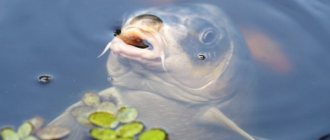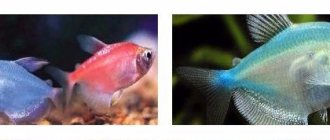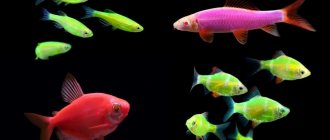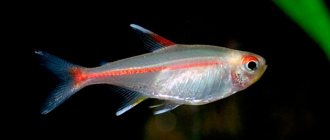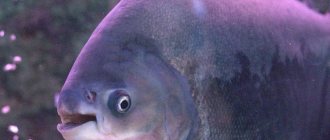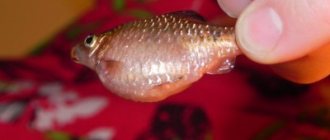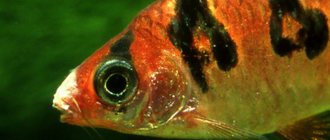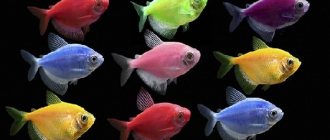Caramel thorns are not compatible with decorative varieties. Such fish are often subject to aggression. In turn, the caramels themselves may suffer from cichlazomas and astronotuses. There will be no deaths, but injuries will continue to appear. When a large flock is formed, the thornets will communicate with each other and ignore most other inhabitants.
Feeding
Ternetias are omnivores; they eat everything they come across in the wild, and behave the same way when kept in aquariums.
Dry, freeze-dried ready-made, live, home-made food from minced meat and herbs - active fish will swallow all this without thinking. But they are prone to overeating and obesity, which will definitely affect their health.
Therefore, they should be fed 2 times a day, pouring into the aquarium such an amount of food that the fish will eat in 3-4 minutes. And at least twice a week you should have fasting days.
How is Caramel different from other types?
Ternetias are small freshwater fish that live in the tropical rivers of South America.
In the 30s of the last century they were brought to Europe, and in 1946 they came to the Soviet Union. Thanks to their unpretentiousness, Ternetias have become very popular, and today they can be found in almost any pet store.
Ternetia vulgaris has a grayish tint to the body, which is not very attractive to aquarists. Fish breeders have come up with a method of artificial coloring: the fry are injected with a coloring pigment. As a result, Ternetia acquires a bright color:
- blue;
- yellow;
- red;
- green.
Because of their diamond-shaped body and colorful skin, these Ternetias became known as Caramels.
It is important to understand that Caramels are not a new species, but just colored ordinary Ternetias. Thus, all breeding and maintenance conditions remain unchanged. In addition, the coloring composition only colors the individual itself, and in no case is it inherited. There are often even cases where a colored fish turns pale over time and becomes gray again.
How to raise Ternetia fry
The spawning has passed, the fry have appeared, but the questions have not decreased. The most important thing will be: what to feed the fry of the ternation in the first days of life?
As soon as they disperse throughout the spawning area, you will feel that there is not enough space for them. Replant into a larger house and be sure to connect the aeration. Gradually reduce the water temperature. This is not hardening - this is how you accustom the baby to the large aquarium in which they will have to live.
Thornets are spawning
At this time they feed on small plankton. It can be replaced with a mixture of crushed flakes (to the state of flour) and water. This food is squeezed out onto the surface of the water in droplets.
As soon as the first month of life has passed, the non-viable individuals have been eliminated, and there is no need to feed the fry of the ternation with anything special. They will double in size, undergo temperature acclimatization, and their diet will include the usual fish food.
Description with photo
As already noted, Ternetii have a flat body, shaped like a rhombus. They usually reach 5-6 cm in length. There are two fins on the back: a sharp dorsal fin and a small adipose fin. A distinctive feature of Ternetius is an elongated anal fin, which is very similar to a skirt.
Appearance of Caramel
The color of the skin can be any. The location of transverse stripes on the body: near the eyes, gills and in the middle of the body is not a sign of Caramel, Glofish may also have the same stripes (read below on how to distinguish Caramel and Glofish).
Diseases
With improper care, various diseases can occur. The main and most common ones:
- Alkali disease. Occurs with increased acidity of water and strong lighting.
- Acidic – with low acidity of water.
- Acedemia – with increased ammonia content.
- Hypoxia occurs in all fish if the aquarium is overcrowded. It is necessary to take into account the number of fish and the volume of the aquarium.
- Chlorosis - when pouring poorly settled water.
Treatment of all diseases comes down primarily to the establishment of living conditions. It is also recommended to increase the water temperature to 30°C.
Aquarium thorns are hardy and suitable for any aquarist. They reproduce well and are not fussy in their maintenance. If you follow the basic nuances of care, the fish will live for at least 5-6 years.
Maintenance and care
Ordinary Ternetias are very unpretentious in care and maintenance, but Caramels need to be monitored more closely. The fact is that chemical coloring negatively affects the health of fish and makes them less resistant to various diseases.
Requirements for an aquarium
Setting up a suitable aquarium for Caramels is not difficult, you just need to follow the recommendations given.
General requirements
Ternetias are active schooling fish that need to be kept in numbers of 8-10 individuals , so they need a lot of free space. The volume of the aquarium must be at least 60 liters. It is better if it is square or rectangular. There must be a lid on top, as Caramels love to frolic and jump out of the water. In the aquarium itself you need to place several driftwood, grottoes and other shelters.
What plants can be used and are they needed?
Ternetias not only love to chase each other, but also to hide, so you should plant a lot of plants for them. For example, cryptocorynes, pinnately or limnophila are perfect.
Another important purpose of plants is to create shady places, since Caramels prefer moderate lighting. This factor also needs to be taken into account when arranging an aquarium.
Which soil should I choose?
Caramels usually swim in the middle and upper layers of water and do not show interest in the ground. In this regard, the composition of the soil can be anything (sand, pebbles, gravel), but it is better if it is dark . This will allow Ternetii to look more beautiful in the aquarium.
What equipment is needed and is a compressor needed?
An aerator (compressor) and a filter must be installed in the aquarium, but it is not recommended to create too strong a flow of water. If the room is warm enough, you can do without a heater.
What kind of lighting should there be?
As already noted, Ternetias do not like bright light, so the lighting should be dim. The lamp should be turned off at night, and during the day you should protect the aquarium from direct sunlight.
Water
Ternetias do not have any special requirements for water parameters:
- the temperature should be 22-26°C;
- acidity – 6.5-8.5pH;
- hardness – 5-15°.
Every week it is necessary to drain 20-25% of the aquarium volume and add water with similar parameters.
Feeding
Caramels are omnivores and readily eat any type of food (dry, live, frozen).
The most important thing is to monitor the diversity of the diet: for example, fish should not be constantly given dry food. Feeding should be done 1-2 times a day, and the portion should be such that Ternetia eats the food in a few minutes . Otherwise, food debris will begin to rot at the bottom and spoil the quality of the habitat in the aquarium.
Diseases
Due to chemical exposure, Caramels have a reduced level of immunity, so the owner must be especially careful about the hygiene of the aquarium. If not properly cared for, fish can become poisoned or suffer from hypoxia (lack of oxygen). In addition, they often develop infectious diseases (costiosis, ichthyophthyriosis, oodiniumosis).
To prevent such diseases, it is important to monitor water parameters, prepare a varied diet and carefully handle all new objects (plants, soil, shelters).
Lifespan
Painted Ternetias live approximately 3 to 5 years. Their lifespan is directly affected by the conditions of detention.
Feeding and diet
These aquarium fish are omnivorous, but not prone to overeating. They are very unpretentious in their diet. They eat dry food, live bait, and various types of substitutes very well. You can also feed bloodworms, daphnia, brine shrimp and other types of frozen food. It is important that the diet is balanced. It is optimal if the food is varied and the thorny’s daily diet includes both dry food and live food.
Most often, aquarium thorns eat food in the middle layers of water, but particles that fall to the bottom will not be lost either. It is better if the food is in the form of flakes and chips, so it sinks to the bottom more slowly.
For bright varieties of thorns, it is necessary to add food to the diet that contains natural color enhancers. This is food with natural dyes, the effect of which is noticeable after 5-7 days of constant use.
Important! When choosing dry food, you need to check the date of manufacture, as well as the composition and store it properly in a closed package.
Reproduction of multi-colored caramels
Caramels readily reproduce between the ages of 8 months and 2 years. Males and females should be placed in a separate aquarium with warmer water and given live food. A special net is placed at the bottom of the spawning tank, which will protect the eggs from being eaten by hungry “parents”. (For the same reason, you should not breed in a community aquarium, as the eggs and fry will be eaten.).
After some time, spawning will occur, after which the adults are returned to the general aquarium. After a few days, the fry will begin to move and eat small food. They will not retain their bright color and will remain silver-gray.
Sex differences. Breeding
The dorsal fin of the male is more narrowed and longer than that of the female. The mature female is more rounded than the male. Ternetia aquarium was bred in captivity, various color forms appeared later, and they have lush fins. Perfect for beginner aquarists who decide to breed fish.
For breeding to be successful, females must live separately from males for 7 to 10 days before spawning begins. They need to be fed live frozen foods. Then they can be run into a 40-liter tank, where a sponge filter and a compressor for aeration should be installed. The water temperature in the spawning area, which stimulates reproduction: from 27 to 30 degrees Celsius. The acidity of the medium is neutral, water hardness is below 15 dH. You can put Java moss in the tank, which will serve as a substrate for the eggs. A separator mesh is also suitable, but the eggs must pass through it without damage.
Breeding will begin when the males begin to chase. The female will lay 500 eggs within 2-3 hours. After successful laying, the spawners must be removed to prevent them from eating the eggs. All unfertilized eggs must be removed in a timely manner so that they do not become covered with fungus. The larvae will hatch in 18-36 hours, and the fry will begin to swim in a few more days.
Maintenance and care of fry: during the first days of life, feed with ciliates. Later, microworms and Artemia nauplii can be given. The biggest problem is that the fry are prone to starvation if they cannot find a food source in a dark tank in a timely manner. Give the fry plenty of light, day and night, until they are large enough. Then they will be able to eat the newly hatched brine shrimp.
Compatibility
Thorns are fish with a low degree of aggressiveness. As a rule, they coexist well with small similar species: guppies, neons, zebrafish. It is important to ensure that there are no species with lush veil fins in the aquarium, since Ternetias like to nibble on such fins. Very small fish (2-3 cm long) can also become victims of active Caramels. For more information about who they get along with best, we recommend reading a detailed article on the topic of compatibility of Ternetius with other fish.
The price of thorns
Ternetias are widespread and can be found in any pet supply store or purchased online. Buying caramels is more expensive than buying ordinary thorns, ranging from 100-130 rubles.
The price depends on color preferences, order volume, age and condition of the fish. Pink thornia is very popular . Bright caramel delights lovers and delights children with its appearance.
No matter how much you have to pay for live fish, the real price is measured not by banknotes, but by genuine interest in the unusual world of the inhabitants of foreign rivers. It is human nature to conduct experiments and transform the world - thorns are proof of this. The purchase of fish obliges the aquarist to treat the small and fragile life of caramels with care and attention.
PECILIIA MICKEY MOUSE: CONTENT IN THE AQUARIUM, PHOTO
PECILIIA HAWAIIAN: CONTENT IN THE AQUARIUM, PHOTO
PECILIA RADISH: CONTENT IN THE AQUARIUM, PHOTO
How to distinguish from Glofish?
In addition to Caramels, Ternetia Glofish is often found in pet stores. This species is genetically modified: jellyfish genes are introduced into the organisms of embryos, due to which the fish acquires a bright fluorescent color. The advantage of this method is that the fish are not exposed to the harmful effects of chemicals, and the genetic code is inherited.
At first glance, Glofish and Caramel are no different from each other, but experienced aquarists can immediately see the differences. The fact is that the body of Glofish itself has a certain shade, which even extends to the eyes and fins. Caramels appear paler - usually only the top and head are best colored, while the belly remains greyish-white.
As an example, here are two photographs that show Caramel and Glofish alternately, after looking at which it will immediately become clear who is who.
Caramel – only the top part and a little of the bottom of the tail are colored.
Glofish - the entire body is painted, with 3 stripes across the body. Sometimes these fish are mistaken for Caramels, because... It is believed that Glofish cannot have transverse stripes on its body, but in fact this is not so.
And these are classic Glofish (no transverse stripes) - the whole body is painted, including the head.
Ternetias are not the only genetically modified fish that glow in the dark; Danio Glofish also has this effect.
Diseases and prevention
Ternetia is considered a hardy fish and tolerates many diseases well, however, it is not immune from them. Below are the diseases to which fish are susceptible, the symptoms by which they can be identified, as well as how to treat and care for the fish.
Floats on its side
If the cause is not damage to the body, then the likely cause is oodinosis, a parasitic disease. To treat fish, they are treated with bicellin (from 750,000 to 1,500,000 units per 100 liters), and repeated treatment is carried out after 3-5 days. The same symptom occurs with tuberculosis - in this case, the fish must be disposed of immediately.
Growth on the lip
It happens when affected by a fungus (for example, ichthyosporidiosis). Sick fish are placed in a separate container and treated with fungicides. The solution should be added several times over three days.
Growth on the head
It can simply occur when the aquarium is overpopulated (in this case, the thorn will behave as usual). If there is no overpopulation, then the problem is again fungi. In this case, the fish is also quarantined and treated with special baths. Add 1 tsp per liter of water. soda and two drops of iodine. The procedure is carried out every other day for a week.
Swims upside down
The problem is hypoxia - oxygen starvation, which is caused by overcrowding of the aquarium. Strong fish can cripple weak ones, which is why they behave this way.
Caused by certain bacterial diseases. The fish should be transplanted into quarantine; the drug “SERA Baktopur Direct” is used for treatment (one tablet per 50 liters).
Red gills
Occurs when the water is poorly saturated with oxygen. Also, sometimes a fish may have such gills from birth, but it can live with them all its life.
Hexamitosis (a string of feces trails behind the fish)
A parasitic disease that affects the intestines. In addition to the string of feces, white dots appear on the body of the fish. The fish are quarantined. A simple and effective method of treatment is to raise the temperature to 33-35 ℃, which leads to the death of the parasites. If the fish’s body is already severely damaged, then it is necessary to use medications, such as metrinidazole.
White rash
The reason is a fairly common infectious disease - ichthyophthyriosis. If the disease is detected in the early stages, it is enough to increase the temperature by a few degrees and increase the oxygen content. Otherwise, the fish should be removed and treated with salt baths or bicillin.
bulging eye
Caused by overpopulation, which in turn leads to water pollution and increased levels of nitrites and phosphates. If the aquarium is not overcrowded, and the bulging eyes are accompanied by other symptoms (such as plaque), then most likely there is an infectious disease.
How to choose the right one when buying, what to look for?
Ternetias are very active fish that should behave agilely and playfully. It is worth paying special attention to the color of the body: it should have a uniform color without spots or light areas. A lethargic, slow and pale fish is unlikely to live long in your aquarium.
Regardless of the condition of new pets, they need to be kept in a quarantine aquarium for a couple of weeks, and only then released into the general aquarium. Healthy Caramels, with proper care, will delight the owner for a long time with their playful character and attractive appearance.
Description and habitat
Ternetia is a small aquarium fish from the characin family that lives in the rivers of Brazil, Paraguay and Argentina. The Latin name is Gymnocorymbus ternetzi, also known by such names as black ternetzi, black widow, black tetra and black skirt. Prefers shaded ponds with dense vegetation.
Appearance
Ternetia reaches a length of 4.5 centimeters (sometimes more). The body is tall, diamond-shaped, flattened laterally. A characteristic feature is a huge anal fin, reaching almost to the middle of the abdomen (reminiscent of the same fin of a bream). There is also a tiny adipose fin, a typical feature of all characins. The scales are silvery in color, with three black stripes (the first goes through the eye). The back of the body, from the third stripe and the anal fin are black. The fan-shaped anal fin and dark tail look like a skirt, which is how the fish got one of its nicknames.
Features of behavior
Active schooling fish. Ternetias settle in rivers and streams with slow currents, densely overgrown and shaded with dark water. They prefer the upper layers of water, where they hunt insects that have fallen into the water. Life expectancy in captivity – 6-7 years
Difficulty in content
Ternetia is extremely unpretentious. Even a novice aquarium owner can maintain and breed it. They are not picky about food, and a change in the color of the body signals that it is necessary to adjust the water characteristics.
Active, moving fish tend to jump out of the aquarium, so it must be covered with a lid or glass. When keeping fluorescent fish, it is necessary to illuminate the aquarium with blue (“actinic”) light, so the fish look more impressive and their color shines brighter. But even in normal light they look good.
Caramel fish nutrition
Caramel is an omnivorous fish, the diet of which can include any type of dry, fresh and frozen food. In this case, it is necessary to frequently alternate food: a monotonous diet (only dry food, for example) is contraindicated for these thorns.
The fish should be fed 1-2 times a day in small portions. The amount of food should be such that the caramels can handle it in a few minutes. Particles of uneaten food will quickly begin to decompose, which will affect the quality of the water.
Kinds
The genus of ternation includes several types and forms:
- Veiled. The veil blackskirt or mourning is an artificially bred form with long fins wavy on the sides. The fins look like a long black skirt, which attracts attention to the inhabitant of the aquarium. Difficult in content.
- Albino. Light color, reddish eyes. There are no transverse stripes on the body. The veil form is rare.
- Caramel. It is dyed by applying dye under the skin. The bright color of such individuals disappears quickly. Caramel thorns live shorter than their natural counterparts and have weak immunity. There are different colors: pink, green, blue, red, purple.
- GloFish is another colorful variation of aquarium fish. GloFish inherits fluorescent color. The average life expectancy is the same as that of black thorns. Colored at the gene level.
- Golden. Light gold fish with a silver tint. There are no stripes on the body.
Advantages and disadvantages
The wide distribution of caramel is associated not only with its multi-colored color, but also with other advantages of its content, which include:
- their peaceful, accommodating nature;
- ease of breeding;
- activity;
- ease of care.
The disadvantages of these fish are considered to be shyness, which is why it is necessary to keep a school of at least 7 individuals. Due to their active lifestyle and curiosity, they harm veiled fish of other varieties by constantly pinching and pulling their tails.
How long do thorns live in an aquarium?
Serene contemplation of the expanses of water can last for these fish for up to 7 years. This is how many years thornets live in an aquarium.
Ternetia lives 5-7 years
This fish is impeccable in everything. She is not picky about food (she even eats boiled pumpkin and steamed spinach!), she is not original in breeding, she lives where everyone else does, and has a pleasant appearance.
Colors
To date, the following color varieties have been developed:
- light green;
- mint;
- blue;
- pink;
- orange;
- red;
- purple;
- blackberry;
- yellow.
Transgenic fish are no different from regular fish. With proper maintenance, their life expectancy is the same as that of the prototype. In addition to transgenic ones, caramel thorns are sold in markets. These fish are artificially colored and, unlike glofish, do not pass on their color to their offspring, and it fades with age.
Fish treated with chemical dyes are less resistant to disease and have a shorter lifespan. The barbaric procedure leads to the death of the fish even at the staining stage. They are placed in a weak acid solution to remove the natural protective layer of mucus. Then they are painted with semi-permanent fluorescent dyes and again immersed in a bath with substances that irritate the mucus-producing glands. Only 10% of processed thorns survive to the shelves.

